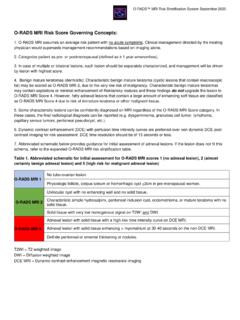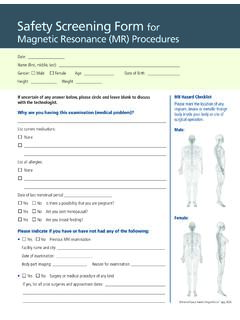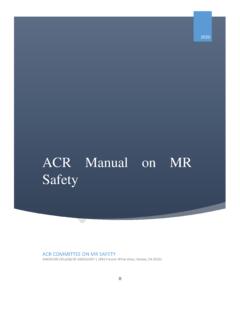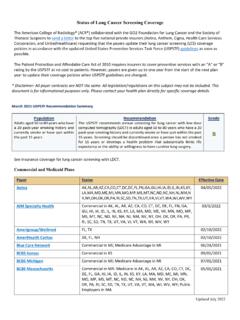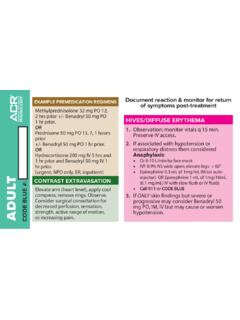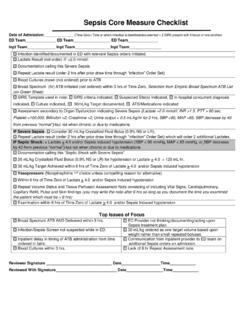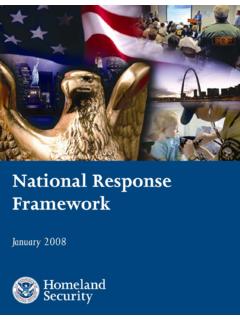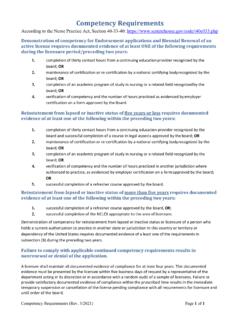Transcription of CT/MRI LI-RADS v2018 CORE - ACR
1 CT/MRI LI-RADS v2018 core . Untreated observation without pathologic proof in patient at high risk for HCC. If cannot be categorized due to image degradation or omission LR-NC. If definite tumor in vein (TIV) LR-TIV. If definitely benign LR-1. If probably benign LR-2. If probably or definitely malignant but not HCC specific ( , if targetoid) LR-M. Otherwise, use CT/MRI diagnostic table below If intermediate probability of malignancy LR-3. If probably HCC LR-4. If definitely HCC LR-5. CT/MRI Diagnostic Table Arterial phase hyperenhancement (APHE) No APHE Nonrim APHE.
2 Observation size (mm) < 20 20 < 10 10-19 20. Count additional major features: None LR-3 LR-3 LR-3 LR-3 LR-4. Enhancing capsule One LR-3 LR-4 LR-4 LR-4 LR-5. Nonperipheral washout LR-5. Threshold growth Two LR-4 LR-4 LR-4 LR-5 LR-5. LR-4 Observations in this cell are categorized based on one additional major feature: LR-5 LR-4 if enhancing capsule . LR-5 if nonperipheral washout OR threshold growth If unsure about the presence of any major feature: characterize that feature as absent OPTN users in USA: see page 15 for conversion of LI-RADS categories to OPTN Classes LI-RADS v2018 Diagnostic Algorithm Treatment Response Last Viewed CT/MRI core Table of Contents Pages What is LI-RADS 2.
3 Overview LI-RADS Algorithms 3. What is new in v2018 4. What's New Why update in 2018 5. Getting Started 6. Categories 7. Step 1. Apply LI-RADS Diagnostic Algorithm 8. Step 2. Consider Applying Ancillary Features 9. Diagnosis Step 3. Apply Tiebreaking Rules if Needed 9. Step 4. Final Check 10. Step 1. Apply LI-RADS Treatment Response Algorithm 11. Treatment Step 2. Measure Viable Tumor Size if Applicable 12. Response Step 3. Apply Tiebreaking Rule if Needed 12. Step 4. Final Check 12. Technique LI-RADS Technical Recommendations 13. Suggested Imaging Workup Options and Time Intervals 14.
4 Management OPTN and LI-RADS 15. Considerations Before Issuing a LI-RADS Report 16. Reporting Reporting: Requirements and Content 18. Imaging Phases 19. Major Imaging Features 20. Tumor in Vein 21. LR-M criteria 22. LR-M Reporting 23. Definitions Ancillary Imaging Features Favoring Malignancy 24. Ancillary Imaging Features Favoring Benignity 25. LI-RADS Treatment Response Features 26. Examples of LR-1 and LR-2 Entities 27. Observation with Infiltrative Appearance 28. LI-RADS v2018 Diagnostic Algorithm Treatment Response Last Viewed CT/MRI core Table of Contents Pages Getting Started 29.
5 What's new 31. LI-RADS Diagnostic Categories 35. LI-RADS Treatment Response Categories 37. Diagnosis 38. FAQs Treatment Response 45. Technique 48. Management 50. Reporting 52. Imaging Features 55. Abbreviations 58. CT/MRI Manual (With References) (pending). Other LI-RADS Documents (pending): US LI-RADS , CEUS LI-RADS , LI-RADS Downloads LI-RADS v2018 Diagnostic Algorithm Treatment Response Last Viewed Overview CT/MRI core What is LI-RADS ? The Liver Imaging Reporting And Data System ( LI-RADS ) is: A comprehensive system for standardizing the terminology, technique, interpretation, reporting, and data collection of liver imaging A dynamic document, to be expanded and refined as knowledge accrues and in response to user feedback Designed to improve communication, patient care, education, and research Supported and endorsed by the American College of Radiology (ACR).
6 Developed by a multidisciplinary, international consortium of diagnostic and interventional radiologists, hepatobiliary surgeons, hepatologists, and hepatopathologists. Contributors include academic and community physicians as well as members in training. LI-RADS may be used for clinical care, education, or research by: Community and academic radiologists Radiologists in training Other health care professionals providing care to patients with liver disease Researchers LI-RADS is consistent with and fully integrated into: AASLD clinical practice guidance LI-RADS is consistent with: NCCN guidelines LI-RADS can be utilized by liver transplant centers in the United States.
7 The conversion from LI-RADS categories to OPTN classes is straightforward. See page 15. 2. LI-RADS v2018 Diagnostic Algorithm Treatment Response Last Viewed Overview CT/MRI core LI-RADS Algorithms For surveillance of HCC. Ultrasound LI-RADS In cirrhotic and other high-risk patients Using unenhanced ultrasound For diagnosis of HCC. CEUS. In cirrhotic and other high-risk patients LI-RADS . Using contrast-enhanced ultrasound (CEUS). For diagnosis and staging of HCC. CT/MRI In cirrhotic and other high-risk patients, including liver Diagnostic transplant candidates with HCC.
8 LI-RADS . Using CT, MRI with extracellular agents (ECA), or MRI with hepatobiliary agents (HBA). For assessing response of HCC to locoregional treatment CT/MRI . In cirrhotic and other high-risk patients, including liver Treatment transplant candidates with HCC. Response LI-RADS . Using CT, MRI with extracellular agents (ECA), or MRI with hepatobiliary agents (HBA). Notes: Multiphase CT or MRI is sometimes used for HCC surveillance, depending on regional guidelines, institutional preferences, and other factors. LI-RADS neither recommends for nor against CT or MRI for this purpose, but LI-RADS may be used to interpret and report those exams if performed.
9 LI-RADS v2017 does not address treatment response with CEUS, or after systemic therapy or surgery. These will be addressed in the next LI-RADS version. 3. LI-RADS v2018 Diagnostic Algorithm Treatment Response Last Viewed What's New CT/MRI core What's New in LI-RADS v2018 ? Revised, simplified definition of threshold growth Threshold growth definition was simplified to: 50% size increase of a mass in 6 months. Rationale: simplicity; achieve concordance with definitions advocated by AASLD and OPTN. AASLD, OPTN, and LI-RADS now have the same definition for threshold growth.
10 Note: the following no longer meet criteria for TG but are considered subthreshold growth: New 10 mm observations in 24 months 100% size increase on imaging exams > 6 months apart Revised, simplified criteria for LR-5: LR-5 criteria were revised to match those advocated by AASLD. The -g and -us designations were eliminated for simplicity. New LR-5 criteria are listed below and summarized in Diagnostic Table (page 8): Size criteria Comments Does not provide exception Nonrim APHE AND. points for liver transplantation Nonperipheral washout . in USA. Nonrim APHE AND both of the following: 10-19 mm Nonperipheral washout Equivalent to OPTN 5A.
